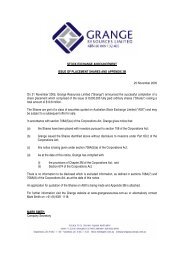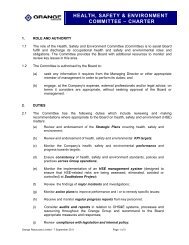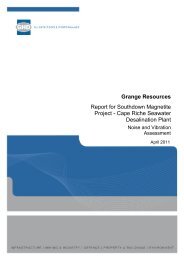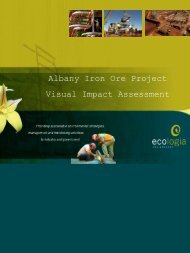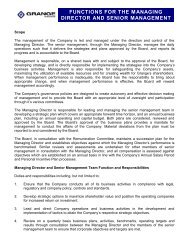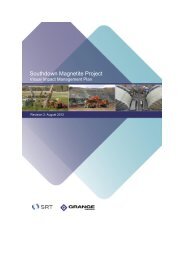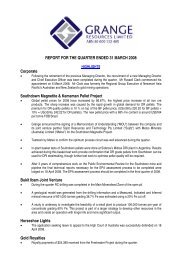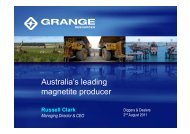2012 Annual Report (2 April 2013) - Grange Resources
2012 Annual Report (2 April 2013) - Grange Resources
2012 Annual Report (2 April 2013) - Grange Resources
You also want an ePaper? Increase the reach of your titles
YUMPU automatically turns print PDFs into web optimized ePapers that Google loves.
64<br />
PAGE<br />
<strong>2012</strong> ANNUAL REPORT<br />
Notes to the Financial Statements (cont.)<br />
NOTE 3. CRITICAL ACCOUNTING<br />
ESTIMATES AND JUDGEMENTS (cont.)<br />
Taxation<br />
The Group’s accounting policy for taxation requires management<br />
judgment in relation to the application of income tax legislation.<br />
There are many transactions and calculations undertaken<br />
during the ordinary course of business where the ultimate tax<br />
determination is uncertain. The Group recognises liabilities for tax,<br />
and if appropriate taxation investigation or audit issues, based on<br />
whether tax will be due and payable. Where the taxation outcome<br />
of such matters is different from the amount initially recorded,<br />
such difference will impact the current and deferred tax positions<br />
in the period in which the assessment is made.<br />
The Group merged its multiple tax consolidated group’s on<br />
6 January 2011 which has impacted the carrying amount of<br />
deferred tax assets and deferred tax liabilities recognised on<br />
the balance sheet. Management have used judgement in the<br />
application of income tax legislation on accounting for this tax<br />
consolidation. These judgements are based on management’s<br />
interpretation of the income tax legislation applicable at the time<br />
of the consolidation.<br />
In addition, certain deferred tax assets for deductible temporary<br />
differences, including MRRT allowances, and carried forward<br />
taxation loses have been recognised. In recognising these<br />
deferred tax assets assumptions have been made regarding the<br />
Group’s ability to generate future taxable profits. Utilisation of the<br />
tax losses also depends on the ability of the tax consolidated<br />
entities to satisfy certain tests at the time the losses are recouped.<br />
If the entities fail to satisfy the tests, the carried forward losses<br />
that are currently recognised as deferred tax assets would have<br />
to be written off to income tax expense. There is an inherent risk<br />
and uncertainty in applying these judgments and a possibility that<br />
changes in legislation will impact upon the carrying amount of<br />
deferred tax assets and deferred tax liabilities recognised on the<br />
balance sheet.<br />
Mineral <strong>Resources</strong> Rent Tax (MRRT)<br />
The enactment and subsequent commencement of the MRRT<br />
requires management judgement in relation to the application of<br />
the Mineral <strong>Resources</strong> Rent Tax Act <strong>2012</strong>.<br />
In assessing the impact of the MRRT on future results, the<br />
Group makes a number of assumptions and estimates, including<br />
commodity price, foreign exchange rates, reserves and resources<br />
for a mining project interest and an expectation regarding future<br />
operating performance which is subject to risk and uncertainty.<br />
In addition, the Group has also determined a market value of<br />
its mining assets as at 1 May 2010. Changes in circumstances<br />
and market conditions may affect any of these assumptions and<br />
estimates and the impact of the MRRT on the group’s future<br />
results. These changes coupled with the impact of the MRRT on<br />
the Group’s future results will be recognised in the period in which<br />
the assessment is made.<br />
Deferred consideration obligation<br />
The Group has recognised a deferred consideration obligation in<br />
relation to a series of payments owing to the previous owners of<br />
<strong>Grange</strong> <strong>Resources</strong> (Tasmania) Pty Ltd as a result of a business<br />
combination in August 2007.<br />
In determining the appropriate level of obligation consideration<br />
is given to the expected gross revenues of <strong>Grange</strong> <strong>Resources</strong><br />
(Tasmania) Pty Ltd and the timing of these expected gross<br />
revenues. Estimates of gross revenue include a number of<br />
assumptions including commodity prices and foreign exchange<br />
rates. Changes to any of the estimates could result in a significant<br />
change to the level of the obligation required, which in turn will<br />
impact future financial results.<br />
Provision for decommissioning and restoration costs<br />
Decommissioning and restoration costs are a normal<br />
consequence of mining, and the majority of this expenditure is<br />
incurred at the end of a mine’s life. In determining an appropriate<br />
level of provision, consideration is given to the expected future<br />
costs to be incurred, the timing of these expected future costs<br />
(largely dependent on the life of the mine), and the estimated<br />
future level of inflation.<br />
The ultimate cost of decommissioning and restoration is uncertain<br />
and costs can vary in response to many factors including<br />
changes to the relevant legal requirements, the emergence of new<br />
restoration techniques or experience at other mine sites. The<br />
expected timing of expenditure can also change, for example in<br />
response to changes in reserves or to production rates.<br />
Changes to any of the estimates could result in significant<br />
changes to the level of provisioning required, which would in<br />
turn impact future financial results. These estimates are reviewed<br />
annually and adjusted where necessary to ensure that the most<br />
up to date data is used.<br />
Share-based payment transactions<br />
The Group measures the cost of equity-settled transactions with<br />
employees by reference to the fair value of the equity instruments<br />
at the date at which they are granted. The fair value for options is<br />
determined by an external value using a binomial model, using the<br />
assumptions detailed in Note 40. The fair value for shares issued<br />
is determined by the volume weighted average trading price over<br />
a specified number of days.



